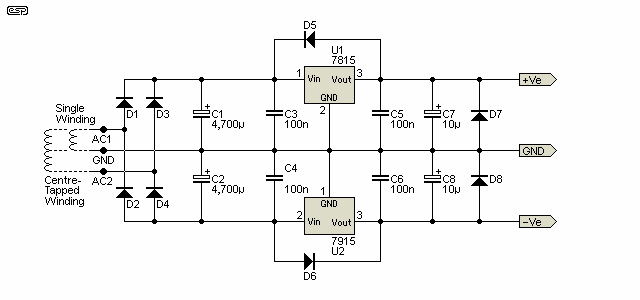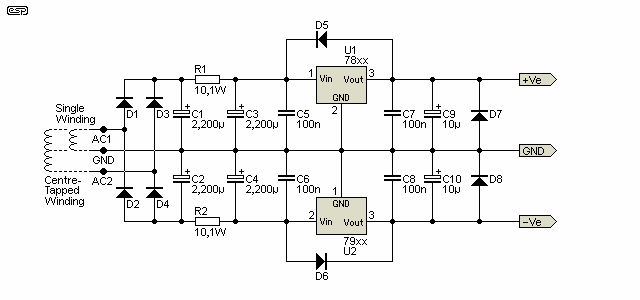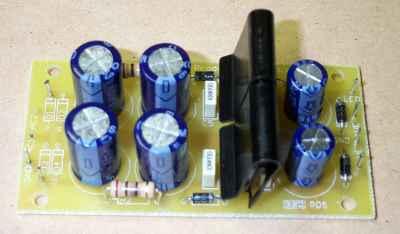

|
| Elliott Sound Products | Project 05 |

| Please Note: PCBs are available for the latest revision (P05-Mini) of this project. Click the PCB image for details. |
Please note that this project is now superseded by P05 Rev-C, and original PCBs are no longer available. However, the project is just as useful now as when it was when first published back in 1999. This version doesn't have any of the 'niceties' of the latest versions, but it's simple, practical, and more than sufficient for many projects. The original PCB is available again as P05-Mini, as this is a cheap and easy way to get regulated voltages for your project.
Preamps may in some cases use a simple regulator, with the supplies taken from the main amp power supply. This can be a problem if the main amp is of more than average power, as the supply voltage will often be too high for 3-terminal regulator ICs. This will also be a problem if the main amp is under warranty or you just don't want to fiddle with it.
For these occasions, a simple, high performance supply can be built using an external AC power pack (no mains to worry about, and you don't even need a power lead). Plug pack transformers (wall warts, wall transformers) are available in a variety of voltages, and if you can find a 16V AC version, this is ideal. With 16V, you can easily get ±15V DC regulated using the circuit shown below. If you cannot find a 16V unit, you can use a 12V version instead, using 12V regulators (7812 and 7912).
Another alternative is to mount a suitable transformer in a plastic or metal box, and just bring the secondary (or secondaries) out on leads with a female line XLR on the end. The mains input can be a fixed lead or an IEC power connector. Remember to ground the chassis of the transformer (if a conventional type) and any metal on the box used. The disadvantage of this is that you will not have the safety factor afforded by the Double Insulation rating of an external AC plug pack transformer, but this is mitigated by the safety earth/ ground.
Note: This supply must be powered from a transformer (preferably 15-0-15V). A single AC supply can also be used, which will typically be 16V AC from a wall transformer. The wall transformer means that there is no need for any mains wiring, which is far safer for people who aren't willing to perform mains wiring. The supply must never be connected to any AC voltage exceeding 20V AC (or 18-0-18V from an internal transformer.
Inclusion of a fuse suitable for the transformer used is highly recommended, and a thermal fuse is a good idea too, since the power transformer may be left on permanently in some installations. Thermal fuses are standard in most (all?) wall transformers to reduce the risk of fire. If a power switch is incorporated in the preamp, this can be a simple low voltage type since no mains voltages are present, and can be in either AC input lead - there is no need to break both leads with the switch. Naturally, if you use a centre-tapped transformer, you will need to break any two of the AC leads with the switch.
The rectifier can be operated with a single winding (keeping in mind Note 3 above), where the AC is connected between AC1 (or AC2) and GND. This is a 'full wave voltage doubler' type, and with an input of 16VAC will provide about ±20V unregulated DC at a current of 100mA - this should be enough for the most power-hungry preamp. All diodes are 1N4002 or similar (100V / 1A minimum rating for all). If you have a transformer with a centre-tapped winding (typically 15-0-15 V), the centre tap connects to GND, and the windings join to AC1 and AC2.

Figure 1 - ±15V Preamplifier Power Supply
The 3-terminal regulators are in the TO-220 package, and unless your preamp requires lots of current, they will not require a heatsink. The regulators are shown using 7815 and 7915 regulators, but use the type needed for the voltage required. They are readily available in 15V (7815, 7915), 12V (7812, 7912) and 5V (7805, 7905). Other voltages used to be common as well, but some have gone by the wayside.
The diodes around the 3-terminal regulators prevent reverse voltages being applied to the regulator chips under any condition. They are not strictly necessary, but are considered a good idea, and should not be omitted. D7 and D8 (at the outputs) may look redundant, but they are definitely required. The 100nF (C5-C8) caps must be close to the IC leads to prevent oscillation. You can use polyester or multilayer ceramic caps, with ceramic being the preferred option because they have better high frequency performance in this role.
Hum filtering can be improved by using the scheme shown below. All PCB versions of the P05 have used this arrangement, and it results in a 100/120Hz hum reduction at the input to the regulator. The reduction is around 17dB at a current of 60mA, and it is especially effective at reducing the harmonics of the ripple frequency.

Figure 2 - Improved ±15V Preamplifier Power Supply
Note the 10Ω, 1W resistors between the filter caps. These are fine for an output current of up to 100mA, but need to be reduced for higher current. No more than 1V should be dropped across these resistors to prevent loss of regulation with low mains voltage or high current. The value can be determined using nothing harder than Ohm's law. The resistors smooth the 'raw' DC and filter out high-order harmonics, ensuring a clean DC output. The extra filtering means that high frequency noise in particular is greatly attenuated, and the output DC is very quiet indeed. However, fixed regulators are noisier than the variable regulators used in later revisions of the P05, so if you need a particularly 'quiet' DC output, the later version is still recommended.
With the values shown, the ripple at the input of C1/ C2 is about 470mV peak/peak with a 100mA load, reduced to around 25mV peak/peak at C3/ C4. This is with a 15-0-15V AC transformer winding with the centre-tap grounded. As the load current is increased, you either need to use a transformer with a slightly higher voltage, or use larger filter caps for C1...C4. As already noted, you also need to reduce the value of R1/ R2. The claimed dropout voltage for the 78xx and 79xx regulators is 2V at 1A. That means that the input voltage must be at least 2V greater than the output voltage, including input voltage ripple.
The recommended input voltages depend on the regulator used. For 15V you should aim for at least 20V at the input, for 12V you need no less than 17V, and for 5V the DC input should be no less than 10V (positive and negative in each case). The 16V transformer suggested for ±15V will typically deliver around 18V AC when lightly loaded, but if you intend to draw significant current from the regulator, you may need to use a higher voltage transformer (and add heatsinks to the regulator ICs!). Rated (maximum) current for the regulator ICs is >1A, but this is rarely needed for preamps.
Use of an XLR connector is but one suggested possibility for the AC inputs, because these devices are extremely rugged, provide very low contact resistance and cannot fall out. They are rather large however, and may be difficult to mount if space is a problem. Right angle plugs are available which can reduce the depth behind the preamp somewhat. Feel free to use the connector you prefer, or the regulator can be located in the same enclosure as the transformer and possibly the remainder of your circuit.

Photo of Completed Unit (Original 1999 PCB Shown)
The photo shows the completed (original) PCB, and has small clip-on heatsinks for the regulators. These will not be needed in many cases, but will do no harm either. Make sure that they are well insulated from each other! In the photo, you will see that the diodes (left hand side) are not used - this unit was powered from an existing ±DC supply in the same case, so they weren't needed.
The PCB can be wired to use a single 16V AC supply, or a 15-0-15 AC supply from a conventional power transformer (both options are shown above) - make sure that the input voltage is at or below ±30V under all operating conditions - this is important. The regulator ICs are specified for an absolute maximum input voltage of 35V, and it's wise to ensure a reasonable safety margin.
To keep dissipation to the minimum, the input voltage under full load (and at the minimum expected mains voltage) should be around 3-5V greater than the output voltage. This includes ripple at the input, so it's important to keep ripple to the minimum with adequate sized filter caps after the rectifier diodes. The 2,200µF caps shown are fine for up to 200mA or so, but may need to be increased for higher current loads. Also remember that ripple is significantly greater if a single transformer winding is used instead of a centre-tapped dual winding. That means you need a slightly higher AC input voltage, and this is the reason I recommend a 16V wall transformer.
 Main Index
Main Index
 Projects Index
Projects Index